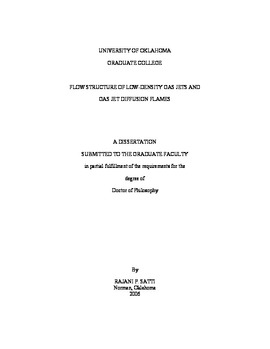| dc.contributor.advisor | Agrawal, Ajay K., | en_US |
| dc.contributor.advisor | Altan, Cengiz M., | en_US |
| dc.contributor.author | Satti, Rajani P. | en_US |
| dc.date.accessioned | 2013-08-16T12:20:24Z | |
| dc.date.available | 2013-08-16T12:20:24Z | |
| dc.date.issued | 2006 | en_US |
| dc.identifier.uri | https://hdl.handle.net/11244/1103 | |
| dc.description.abstract | Buoyant jets and flames have been a subject of significant research in fluid dynamics. Such flows are influenced by near field instabilities, turbulence, buoyancy, chemistry, heat release, etc. The present research deals with computational and experimental studies to improve understanding of laminar-turbulent jets and flames. | en_US |
| dc.description.abstract | As a first step, computational analysis of the near-field flow structure in an isothermal helium jet injected into quiescent ambient air environment was conducted. The jet Reynolds number, Re was varied from 40 to 150 to encompass steady and oscillating jet flow regimes. At low jet Reynolds numbers, the flow was steady and the concentration shear layer at the tube exit was stratified by mixing between jet and ambient fluids inside the tube. At higher jet Reynolds numbers (Re = 90 and 150), buoyancy induced acceleration contracted the jet core to form a toroidal vortex by entrainment of the ambient fluid. Next, the effects of buoyancy on buoyant and inertial low-density gas jets were studied by initiating computations in Earth gravity and subsequently, reducing the gravity to simulate microgravity conditions in the 2.2 s drop tower. | en_US |
| dc.description.abstract | As a successive step towards development of advanced optical diagnostic systems for measuring fluid flow phenomena in small scale turbulent structures, a miniature rainbow schlieren deflectometry system to non-intrusively measure species concentration and temperature data across the whole field was developed. The capability of the system was demonstrated by obtaining concentration measurements in a helium micro-jet (diameter, d = 650 mum) and temperature and concentration measurements in a hydrogen jet diffusion flame from a micro-injector (d = 50 mum). Finally, the flow field of under-expanded nitrogen jets was visualized to reveal details of the shock structures existing downstream of the jet exit. | en_US |
| dc.description.abstract | From an experimental perspective, in order to facilitate turbulence measurements, a crossbeam rainbow schlieren deflectometry system was developed and demonstrated by presenting schlieren visualizations of turbulent jets and flames. Subsequently, the theoretical framework of the crossbeam correlation technique requiring assumptions of homogeneous and isotropic turbulence was presented. The validity of the technique was also verified using laminar and turbulent data generated synthetically. The limitations of the technique were also discussed. | en_US |
| dc.format.extent | xxii, 261 leaves : | en_US |
| dc.subject | Turbulence. | en_US |
| dc.subject | Helium. | en_US |
| dc.subject | Jets Fluid dynamics. | en_US |
| dc.subject | Engineering, Mechanical. | en_US |
| dc.title | Flow structure of low-density gas jets and gas jet diffusion flames. | en_US |
| dc.type | Thesis | en_US |
| dc.thesis.degree | Ph.D. | en_US |
| dc.thesis.degreeDiscipline | School of Aerospace and Mechanical Engineering | en_US |
| dc.note | Advisers: Cengiz M. Altan; Ajay K. Agrawal. | en_US |
| dc.note | Source: Dissertation Abstracts International, Volume: 67-10, Section: B, page: 6020. | en_US |
| ou.identifier | (UMI)AAI3237836 | en_US |
| ou.group | College of Engineering::School of Aerospace and Mechanical Engineering | |
